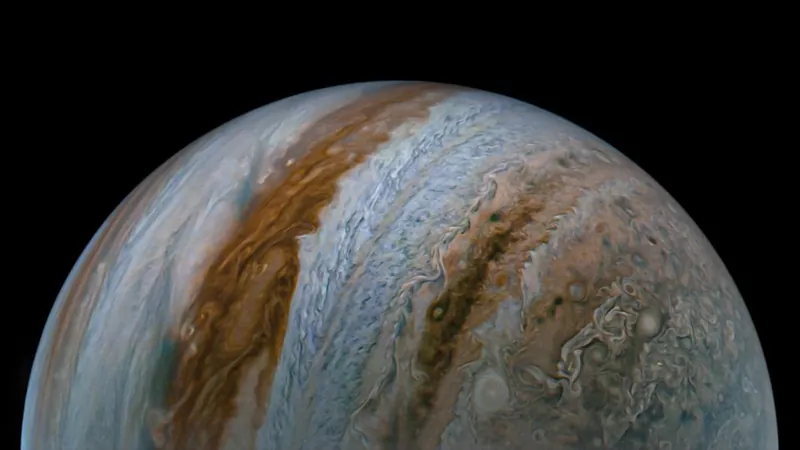
Shocking Discovery: Solar Winds Compress Jupiter's Magnetic Field Like Never Before!
2025-04-03
Author: John Tan
Groundbreaking Revelation
In a groundbreaking revelation, scientists have unveiled that a massive solar windstorm in 2017 dramatically compressed Jupiter's magnetosphere, likening the phenomenon to "a giant squash ball." This extraordinary finding stems from an analysis of unusual temperature patterns detected in Jupiter's atmosphere, conducted with the help of the Keck Observatory in Hawai'i.
Jupiter's Polar Auroras
Jupiter's polar auroras, akin to Earth's northern lights, typically play a significant role in heating the gas giant's upper atmosphere near the poles. However, unlike Earth’s auroras, which are generated through direct interactions with solar particles, Jupiter's auroras are far more intense and originate from a distinct mechanism.
Unexpected Temperature Patterns
Researchers from the University of Reading in England observed unexpectedly high temperatures—reaching upwards of 930 degrees Fahrenheit (500 degrees Celsius)—stretching across half of Jupiter's circumference. This is substantially higher than the usual atmospheric temperature of about 660 degrees F (350 degrees C), leaving scientists puzzled. They noted a surprising lack of heating mechanisms capable of producing such high temperatures outside the auroral region, leading them to suspect that this superheated area was propelled toward the equator from the poles.
Methodology of Investigation
To thoroughly investigate this anomaly, the team married ground-based observations from the Keck telescope with data from NASA's Juno spacecraft, which has been probing Jupiter and its moons since 2016. Their analysis linked this striking increase in temperature to a dense burst of solar winds that compressed the planet's immense magnetosphere—a magnetic bubble that helps protect the planet from solar radiation.
Significance of the Findings
James O'Donoghue, the lead author of the study, exclaimed, "We have never captured Jupiter’s response to solar wind before, and the way it changed the planet's atmosphere was completely unexpected. This is the first time we've ever witnessed anything like this on any outer planet."
Impact on Jupiter's Atmosphere
The compression of the magnetosphere due to the solar wind appears to have significantly intensified the heating of the auroras at Jupiter's poles, causing a spillover effect of hot gas typically confined to those regions. "The solar wind squished Jupiter's magnetic shield like a giant squash ball," O'Donoghue noted. With Jupiter's diameter being an astonishing 11 times larger than Earth's, the scale of this heated region is truly mind-boggling.
Frequency of Solar Wind Events
Further evidence reveals that such solar wind events may strike Jupiter approximately two to three times each month, challenging the previously held belief that the planet's rapid rotation would protect it from these forces. Instead, the findings illustrate that even the largest planet in our solar system is not impervious to the sun's influence.
Conclusion
"We've been studying the giant planets—Jupiter, Saturn, and Uranus—more closely over the last decade. What we’ve learned is astonishing: These behemoths are not as resilient to solar activity as we once thought. They are just as vulnerable as Earth," O'Donoghue stated.
This research illuminates the complex interplay between solar winds and planetary atmospheres and raises critical questions about how this knowledge can enhance our understanding of other celestial bodies. What other surprises does our solar system have in store for us? Stay tuned as scientists continue to unravel the mysteries of the cosmos!

 Brasil (PT)
Brasil (PT)
 Canada (EN)
Canada (EN)
 Chile (ES)
Chile (ES)
 Česko (CS)
Česko (CS)
 대한민국 (KO)
대한민국 (KO)
 España (ES)
España (ES)
 France (FR)
France (FR)
 Hong Kong (EN)
Hong Kong (EN)
 Italia (IT)
Italia (IT)
 日本 (JA)
日本 (JA)
 Magyarország (HU)
Magyarország (HU)
 Norge (NO)
Norge (NO)
 Polska (PL)
Polska (PL)
 Schweiz (DE)
Schweiz (DE)
 Singapore (EN)
Singapore (EN)
 Sverige (SV)
Sverige (SV)
 Suomi (FI)
Suomi (FI)
 Türkiye (TR)
Türkiye (TR)
 الإمارات العربية المتحدة (AR)
الإمارات العربية المتحدة (AR)